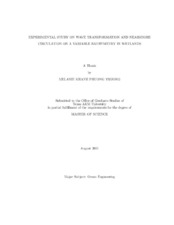| dc.contributor.advisor | Socolofsky, Scott A. | |
| dc.creator | Truong, Melanie Khanh Phuong | |
| dc.date.accessioned | 2012-10-19T15:29:35Z | |
| dc.date.accessioned | 2012-10-22T17:59:28Z | |
| dc.date.available | 2012-10-19T15:29:35Z | |
| dc.date.available | 2012-10-22T17:59:28Z | |
| dc.date.created | 2011-08 | |
| dc.date.issued | 2012-10-19 | |
| dc.date.submitted | August 2011 | |
| dc.identifier.uri | https://hdl.handle.net/1969.1/ETD-TAMU-2011-08-10157 | |
| dc.description.abstract | Hurricanes are one of the primary threats to the Texas coastal environment and economy. They generate large wave and storm surges that have caused much damage on the Texas coast in the past. Understanding both the hydrodynamic processes that damage coastal habitats and hurricane hazard and risk are critical to preserve coastal vegetation and quantify its benefits to coastal storm protection. The goal of this project is to quantify the impact of wave attenuation and wave refraction as well as the development of coherent structures in marsh fringes and the formation of a rip current system over wetlands on storm protection. The 3D Shallow Water Wave Basin at Texas A&M University hosted a series of large-scale experiments considering an idealized wetland model to pursue this goal.
Study of the marsh geometry of the Texas coast was done in order to scale the experiments to the size of the Haynes Laboratory 3D-Water Wave Basin using a Froude and a Reynolds scalings. Particularly, averaged size and idealized shape of marsh segments in the area of Dalehite Cove in Galveston Bay were considered. Three sets of different wave conditions and water levels were tested to approximate different intensities of storm surge. Identical tests with both vegetated and non-vegetated marshes were run to compare the influence of the vegetation in storm conditions, and three different spacings between marsh segments were tested.
In the basin, normally incident regular waves were generated at three water circulation structures. Data analysis allows the determination of the impact of discontinuous marsh segments on wave attenuation and wave refraction. Coherent structures such as rip current and the circulation pattern were analyzed to study the change in the flow field during passage of the waves.
The experimental measurements were able to describe the wave transformations over the marsh segments. The influence of coastal wetlands was identified to affect the hydrodynamic process and reduce the total wave energy which is dissipated and redistributed by vegetation. The presence of the mounds induced an important decrease in the wave height, in addition to the damping of the waves by the vegetation stems. The variation in spatial coverage of the wetland model has been shown to highly affect the flow dynamics by generating offshore directed flow in the channel and onshore directed flow on the marsh mounds. This experimental approach provides a further understanding of flow dynamics by waves and surge in wetlands, at a large scale. | en |
| dc.format.mimetype | application/pdf | |
| dc.language.iso | en_US | |
| dc.subject | Wetland | en |
| dc.subject | Hydrodynamics | en |
| dc.subject | Storm damage reduction | en |
| dc.subject | Rip current | en |
| dc.subject | Wave attenuation | en |
| dc.subject | Vegetation | en |
| dc.title | Experimental Study on Wave Transformation and Nearshore Circulation on a Variable Bathymetry in Wetlands | en |
| dc.type | Thesis | en |
| thesis.degree.department | Civil Engineering | en |
| thesis.degree.discipline | Ocean Engineering | en |
| thesis.degree.grantor | Texas A&M University | en |
| thesis.degree.name | Master of Science | en |
| thesis.degree.level | Masters | en |
| dc.contributor.committeeMember | Irish, Jennifer L. | |
| dc.contributor.committeeMember | Stoessel, Achim | |
| dc.type.genre | thesis | en |
| dc.type.material | text | en |


